
How To Do A Backlink Audit: A Complete 2025 Guide
Whether you’re completely new to the world of link building or you’ve been at it for a while, your business could benefit from a backlink audit.
Backlink audits help you understand your link profile and your performance better. They also give you insight into your competitors which can help you stay ahead of the game.
This type of audit will assist you in discovering:
✅ Why referring domains link to your website.
✅ What pages they link to.
✅ Potential issues, such as spammy and toxic backlinks.
With this information, you can create more effective link building strategies and avoid the risk of a Google penalty (more on this later).
In this article, we will discuss:
➡️ What a backlink audit is and why you should perform one.
➡️ 8 simple steps for carrying out your link audit.
➡️ The best tools for a link profile audit.
What Is a Backlink Audit?
A backlink audit is a thorough analysis of the links pointing to your site.
These are links on other websites—also called referring domains—that direct users to your own website.
By reviewing your backlinks, you’ll be able to identify harmful or toxic links and find opportunities for future link building.
Performing a backlink audit is also an essential step whenever you take over any new site.
It shows you exactly what you are working with and lets you fix errors like bad backlinks before implementing other strategies.
You can also use a basic backlink audit to benchmark your website’s metrics before conducting a link building campaign.
When you know your starting point, you can determine if the strategies you’re implementing generate links the way you want them to.
You should also consider performing a backlink audit if you have an existing site you haven’t yet audited.
You may find opportunities to improve that you didn’t know existed, such as posts that have attracted many high-quality links and organic search traffic.
Why Perform a Backlink Audit?
A complete link audit lets you see the bigger picture and shows you how your backlink profile compares to the competition’s.
There are a couple of reasons why even a basic backlink audit can benefit your search engine optimization (SEO) efforts and attract organic traffic to your website.
1) Benchmark Your Site
A backlink audit provides essential information about your website’s backlink profile. You can use this to benchmark your website.
Use the link data you obtain to measure the impact of your link building activities and gauge your success so far.
2) Discover Bad Links
Bad backlinks—also known as toxic backlinks—affect how your website ranks on search engines like Google.
For example, too many external links from link schemes or private blog networks (PBNs)—whether you generated them intentionally or not—can result in link penalties.
What Are Link Penalties? 🤔
A link penalty, also known as a Google Penalty or manual action, is when a human reviewer decides that your link profile goes against their Webmaster Guidelines.
Link penalties are usually brought against websites with toxic, spammy, or dangerous links.
This is why it’s so important to ensure that your website has a healthy backlink profile.
👉 We will discuss link penalties and what to do about them later in this article.
While Google’s algorithm can increasingly ignore such links, some do get through.
If you suspect that links are affecting your rankings, it’s often best to remove them.
A backlink audit will highlight any problematic or low-quality links.
You can then use this information to assess whether the links negatively affect your website. If they do, you can take steps to remove them.
3) Find opportunities
A backlink audit is also essential for finding new opportunities.
The results of your audit should influence your future campaigns.
For example, you can see the type of content on your website that generates the most links.
Creating more content like this can result in even more links.
4) Suss out the competition
A link audit can help you gain a greater understanding of how your competitors’ sites are performing.
As you know, you always want to stay one step ahead of your competitors wherever possible.
A thorough link audit can provide insight into what your competitors are up to, and it can give you new ideas on how to outperform them.
For example, if you find that a piece of content on your competitor's website performs particularly well with receiving backlinks, you can create similar content and seek out those links.
Before You Start: Choose a Backlink Audit Tool
Now that you know what a link audit is and why you should do one, you probably want to know where to start.
The first thing you need is the right tools to perform a backlink audit. There are several tools you can use, with both free and paid options.

Let’s discuss some of the most popular tools for a link profile audit.
1) Google Search Console
Google Search Console gives you backlink data straight from Google. It provides plenty of useful insights, including:
✅ How many backlinks are pointing to your site.
✅ Anchor text: Google Search Console shows you all the anchor text other websites are using when they link to your page.
✅ Your most linked web pages.
✅ The sites that link to your pages.
✅ Manual link penalties (if you have any).
It’s also a good idea to set up Google Analytics for your website, as this tool provides important metrics, too.
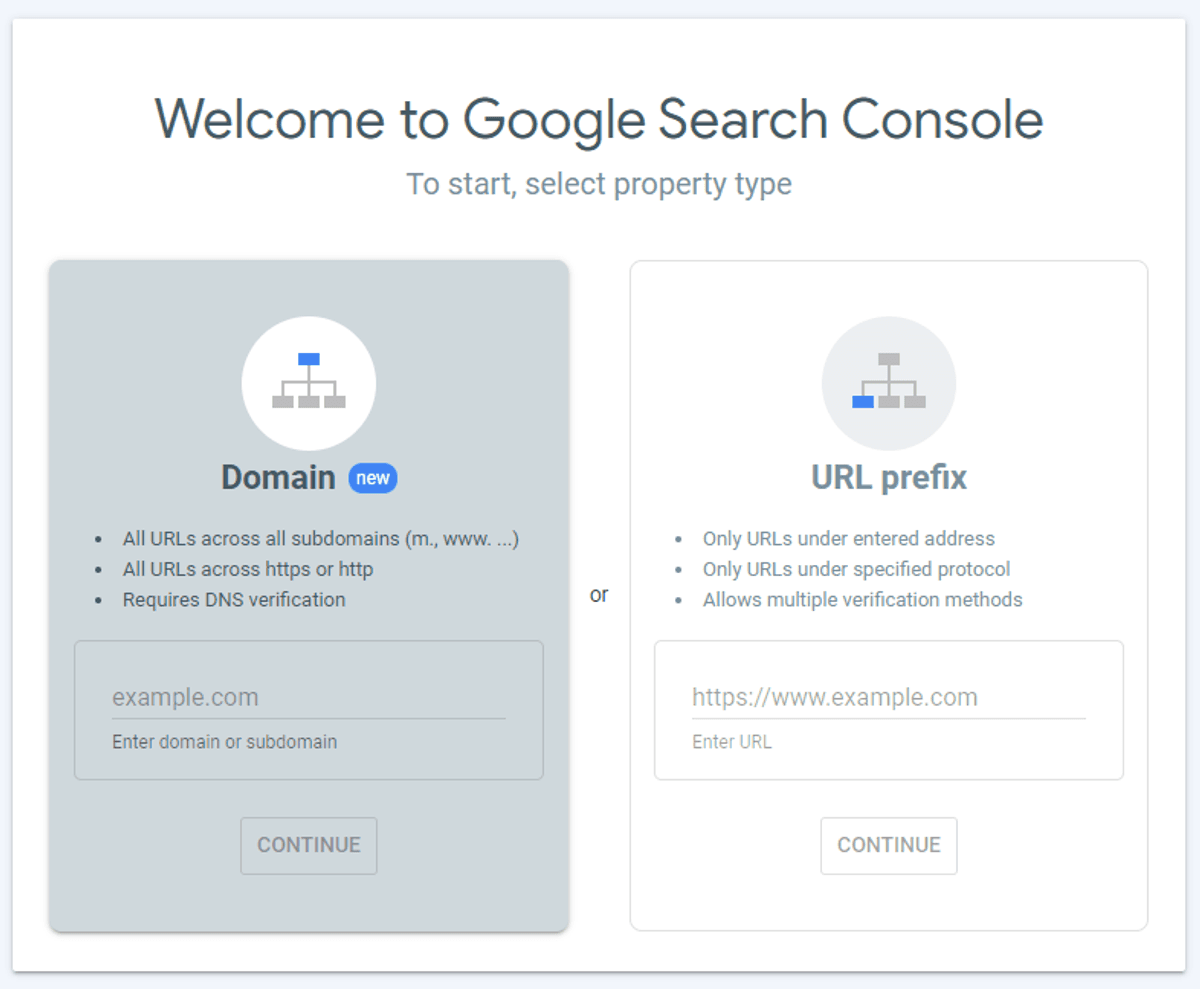
👍 Google Search Console is completely free.
👎 However, the biggest issue is that it doesn’t provide as much link context as other tools.
This makes it difficult to assess link quality and spot problems or opportunities using Search Console alone.
2) Ahrefs
Ahrefs is a popular backlink audit tool, and it’s the one that we use at LinkBuilder when performing a link profile audit.
It provides in-depth information about your backlink profile, such as:
✅ The number of referring domains (domains linking to your site).
✅ Your domain rating (DR). This is a score that rates your backlink profile out of 100 compared to other websites.
✅ Your pages that are receiving the most backlinks.
✅ Anchor text data: Information about your anchor text on other websites linking to yours.
✅ The country of the referring domains.
👍 The biggest benefit of Ahrefs over Search Console is that it provides a lot of context around each link. And DR is an easy way to assess the link profile of both your website and others.
👎 The biggest issue is that Ahrefs’ pricing starts at $99 monthly, which may be steep for those starting out.
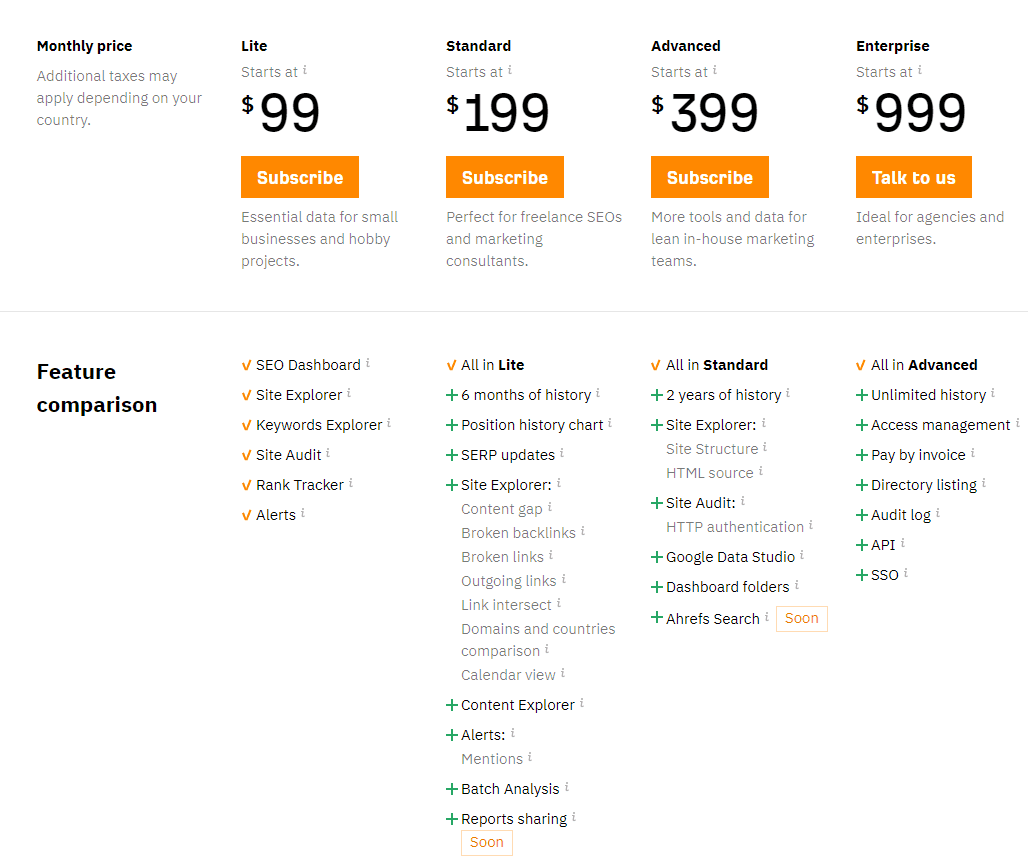
3) Moz
Moz is another popular tool that provides plenty of essential backlink data.
Using Moz, you will be able to access your:
✅ Total referring domains.
✅ Total inbound links.
✅ Domain authority (DA).
✅ Linking sites by domain authority.
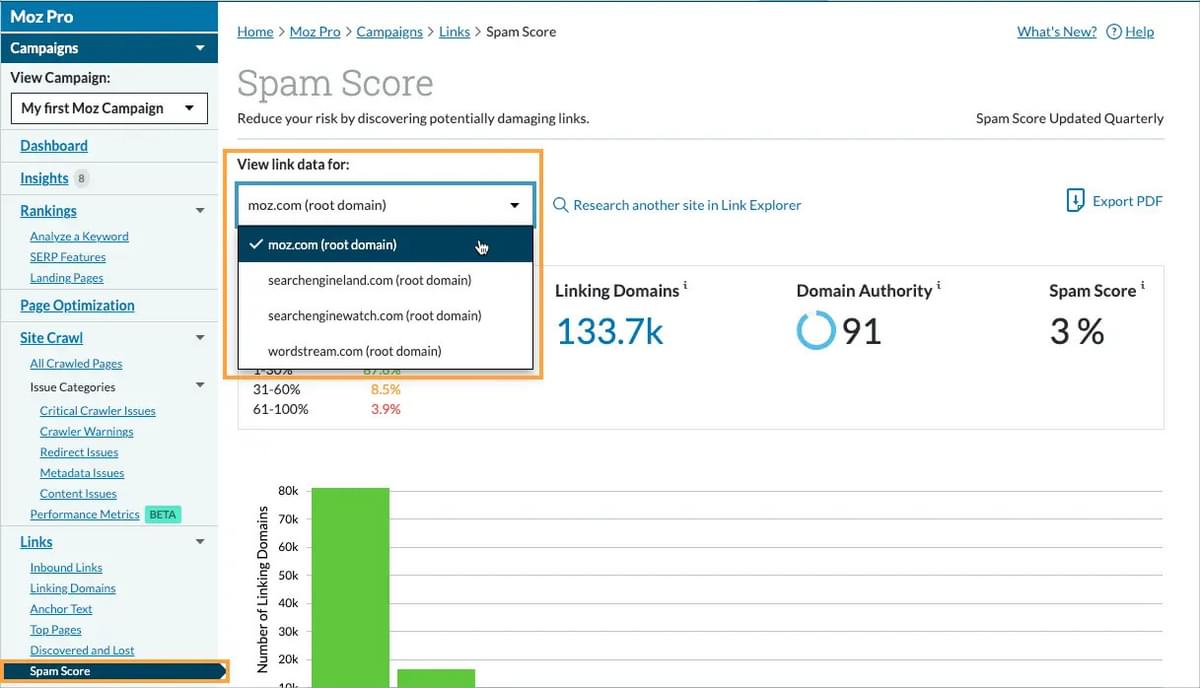
👍 One of the best metrics Moz offers is Spam Score, which is a quick way to assess how spammy a site’s backlink profile is.
👎 Moz’s pricing starts at $99; however, you can try out most of the tools for free.
4) Other SEO Tools
Have you ever heard of a Semrush backlink audit? Semrush is another useful tool that you may want to consider for your link audit.

Most tools will provide the metrics you need for backlink analysis. Majestic and SpyFu are also good alternatives to the above list.
How to Perform a Backlink Audit: An 8 Step Process
You’ve got the right tools, now it’s time to start your backlink audit. Here are eight simple steps to get you started.
1) Benchmark Your Website
The first step in any backlink audit is to get an overall view of your backlink profile.
Use this information to assess how your website is currently performing so you can measure any improvements you make.
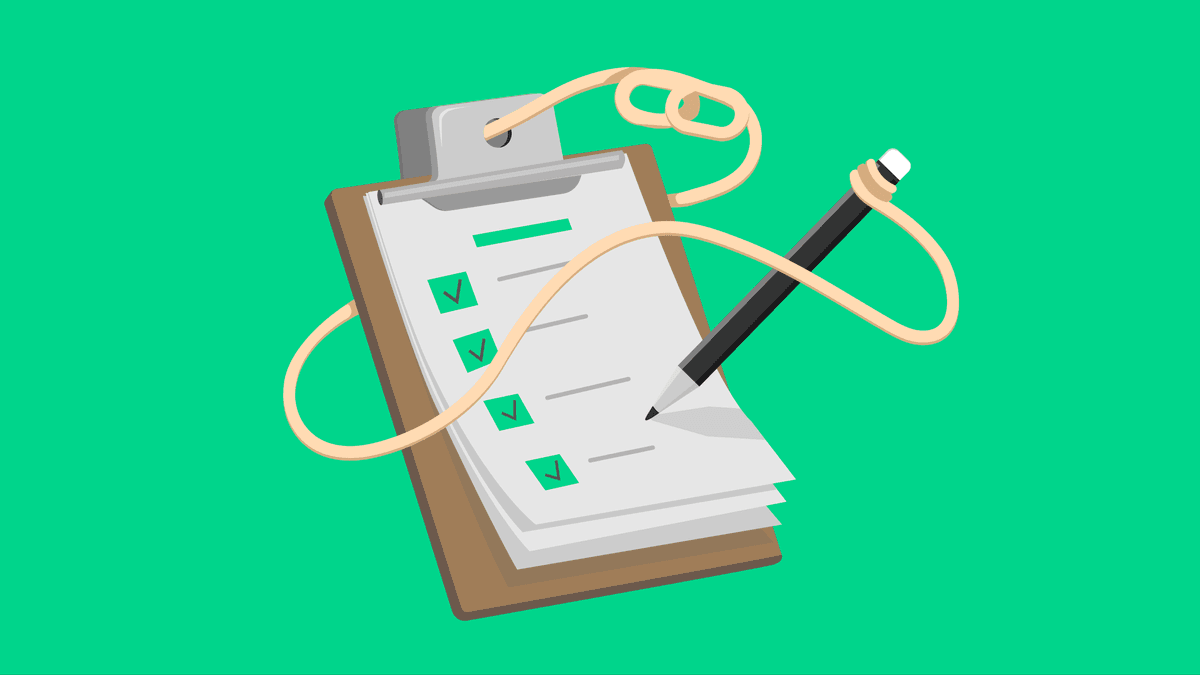
There are several factors to consider if you want to benchmark your website effectively.
➡️ The number of backlinks
This is the total number of backlinks pointing to your site. Count each link, even ones that come from the same referring domain.
➡️ The number of referring domains
Referring domains are the number of domains—or websites—that link to your site. If a single domain links to you multiple times, only count it once.
➡️ The number of dofollow links
Dofollow backlinks are those that Google’s algorithm considers when ranking websites. They are far more valuable than nofollow links.
What Are Dofollow and Nofollow Links? 🤔
👉 Dofollow links are the ones that search engines will allow to point to your website.
👉 Nofollow links are those that don’t pass any authority to your website. This type of link is not helpful when it comes to link building.
➡️ Your website’s authority
Most SEO tools provide a domain authority (DA) score based on the quantity and quality of the links that point to your site.
Use these metrics to get a quick overview of your site’s backlinks.
We use Ahrefs’ DR, but there are many tools available to check your domain authority score.
➡️ Your link acquisition rate
This will show you how fast your site has been acquiring links.
When you start a link building campaign, you’ll want to acquire links at a faster rate than this.
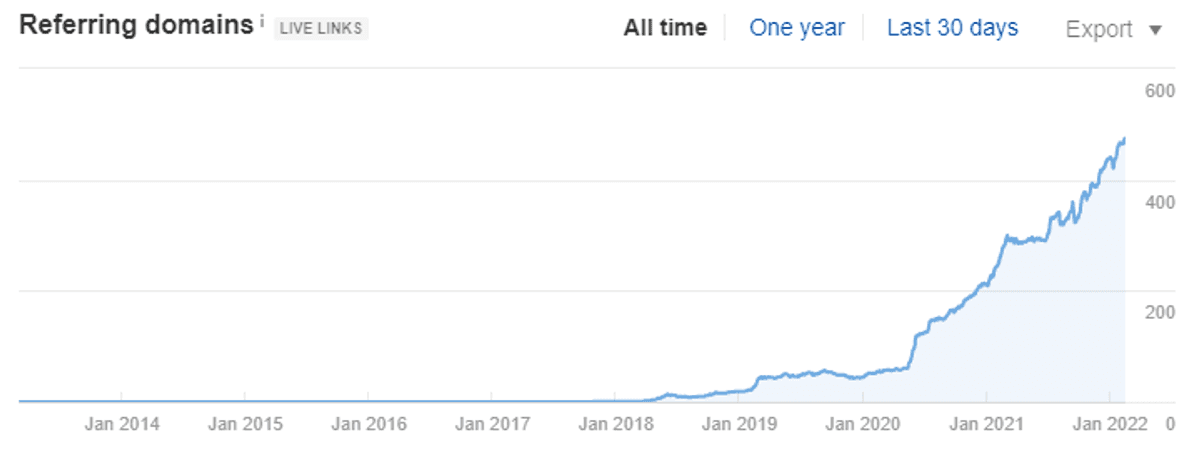
Noting all these metrics will provide a clear overview of your website’s current backlink profile.
2) Discover the Content People Link To
The next step is to find the content on your website that people already link to.
This information is essential because:
✅ Articles people already link to are good candidates for linkable asset outreach campaigns.
✅ Creating pieces similar to the content that already generates links is a proven way to get more links.
✅ You can use internal linking to direct link juice from your most linked pages to high-value pages.
You can easily find your pages with the most links in Google Search Console by clicking on “Links” in the sidebar and then viewing the “Top Linked Pages” report.
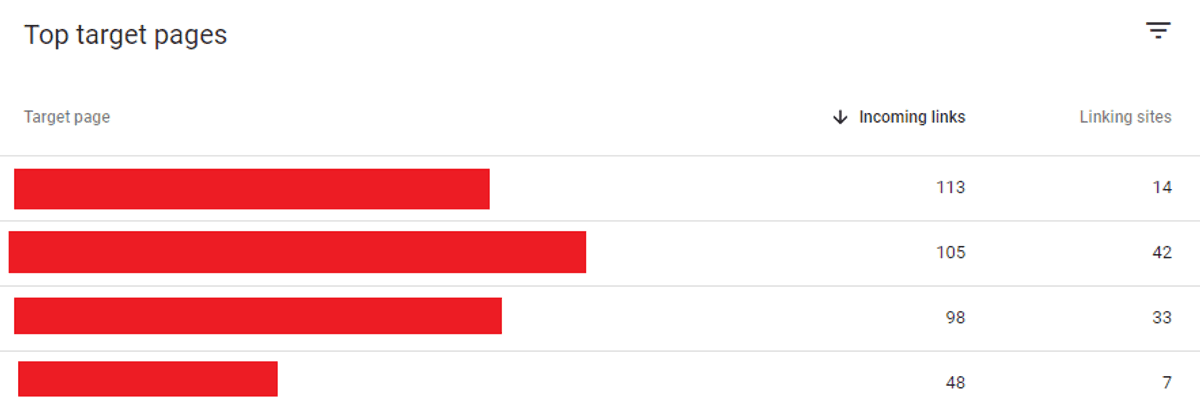
You can also use Ahrefs or Moz to get more information about your top pages.
On Ahrefs, just click the report for “Best by links” in the “Pages” section.
Example: top pages on Neil Patel’s website
Below are the pages with the most links on Neil Patel’s website:
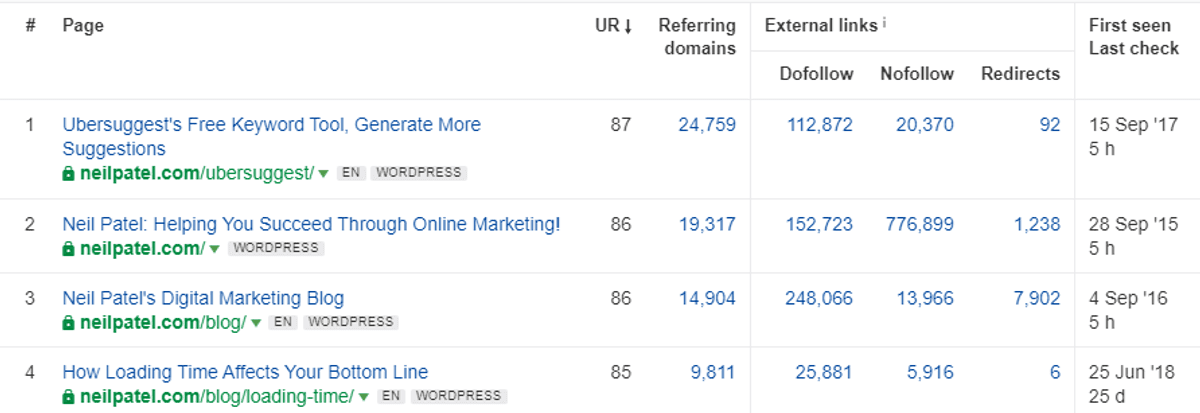
Of the top four pages, one is a free keyword tool, and one is a page with plenty of statistics relating to page loading time.
If we were Neil Patel and wanted to build links, we would consider building more free tools, creating more statistics pages, or producing content around page speed.
The chances are that Neil Patel has already run a backlink audit and has come to the same conclusion.
That’s because some of his other most linked pages include:
👍 Free tools for A/B testing and SEO analysis.
👍 Several articles on page speed.
👍 A page filled with content marketing statistics.
Simply Creating Content Isn’t Enough to Generate Links
Keep in mind that you also need a strategy for getting your content in front of people. After all, people can’t link to your content if they don’t know it exists.
This could mean using a blogger outreach strategy, creating linkable content around keywords you think you can rank for, or using a public relations (PR) link building campaign.
3) Look for Link Types
There are many ways to generate backlinks. Knowing the types of links your site already has can inform your future campaigns.
This is a good step to take if you have a new website, whether that’s because you’ve just bought it or because you are taking over SEO from a previous company.
Head to the “Backlinks” section in the “Backlink Profile” menu of Ahrefs to see all your links.
You can also order the links by DR to see those from authoritative websites first. Or filter the list, so you only see dofollow links.
Common types of links to look out for include:
➡️ Guest Posts: Guest post backlinks are when you write articles on other websites that link back to your own. They are a great way to generate high-quality links and also allow you to link to specific pages on your website.
➡️ Roundups: Roundup articles are those where multiple experts provide opinions on a particular topic. If a website has a lot of links from this type of article, it may indicate that they’re using a service like Help a Reporter Out (HARO) to generate backlinks.
➡️ Niche Edits: Niche edits are paid links. Paid links occur when one website pays another to link directly to them. A clear sign of paid backlinks is when a website has a lot of links with keyword-match anchor text. Or if they have links that don’t add much to the article. If you see a lot of these links, it could be a sign that the website has used this link building strategy before.
4) Identify and Disavow Links
This is a very important 'defensive' play.
So far, we’ve focused on discovering SEO opportunities. But you should also use a backlink audit to identify links that could harm your website.
You can then take steps to remove these links.
Here’s how to do it:
Step One: Check for Manual Actions
If you’re taking over a new site, the first place to look is Google Search Console to find out if you have any manual actions.
Click on the “Security and Manual Actions” tab in the sidebar. Hopefully, you’ll see a “No issues detected” message like in the image below.
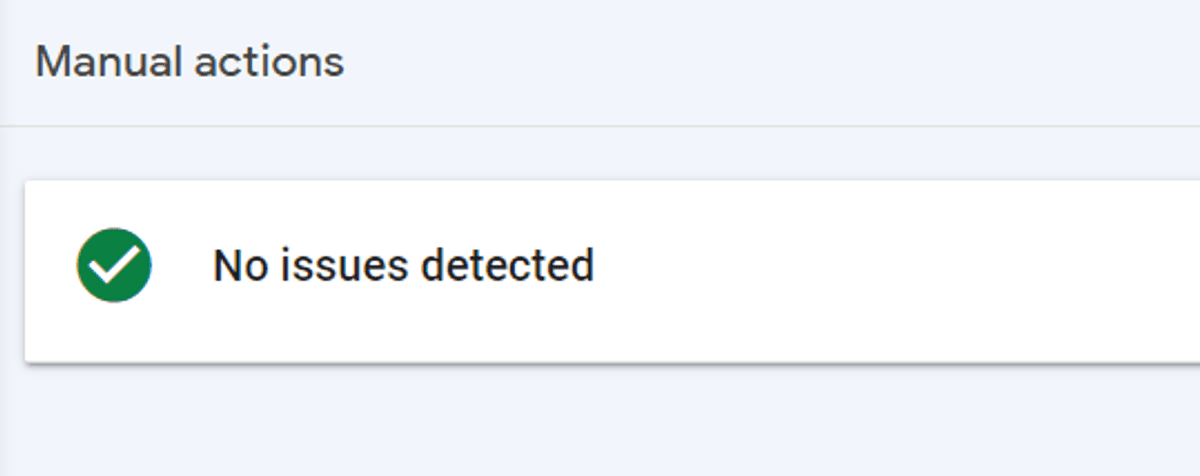
But if you see a manual action, taking care of this should be your priority, as it will be tough to rank with this in place.
The manual action message will provide more information about your next steps, but it will likely mean you need to disavow links.
You can then submit a reconsideration request to tell Google that you have fixed the issue.
You would need to upload a spreadsheet with all the domains you want to disavow in Google Search Console.
👉 Read our detailed guide on how to disavow links.
Step Two: Check for spammy and toxic backlinks
Even if you don’t have a manual action, it’s still a good idea to check your website for spammy backlinks.
A spammy backlink includes those acquired from link farms, link schemes, PNBs, and irrelevant blog comments.
Step Three: Check your spam score
One of the easiest ways to do this is to use the Moz Spam Score. It shows the percentage of incoming links from sites with similar features to those penalized by Google.
You’ll see a breakdown like the one in the image below. The lower your Spam Score, the better.
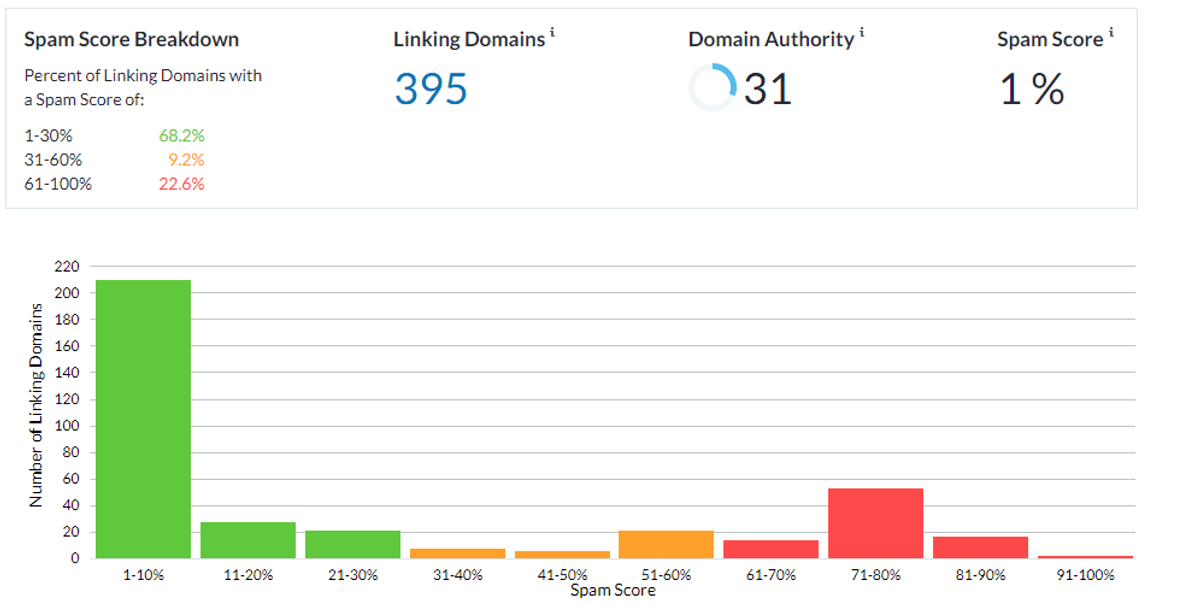
Moz also shows a list of your links organized from highest to lowest spam score. This is an easy way to identify potential culprits to remove.
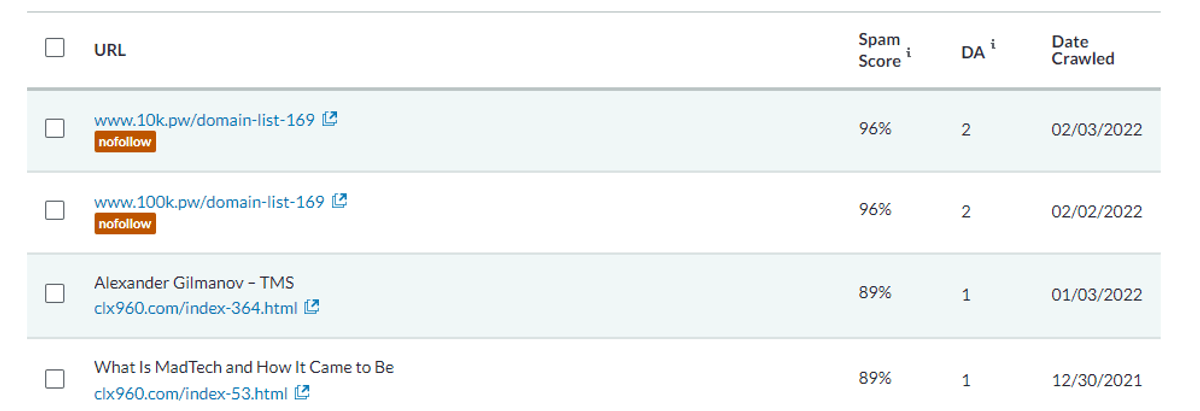
Step four: Check your ccTLD distribution
Country Code Top-Level Domains (ccTLD) are the domain endings that suggest a website is from a particular country. For example, .co.uk for the United Kingdom, or .in for India.
Links from websites with ccTLDs unrelated to your website are often suspicious.
If all your content is in English, but you have a lot of links from China, these links may be spam.
You can see this information in the Ahrefs “Backlink Overview” report.
Most web pages will generate some links from countries that aren’t relevant to their site. And not all of these links are necessarily spammy backlinks.
But if the percentage of links from these countries is disproportionately high, you should investigate.
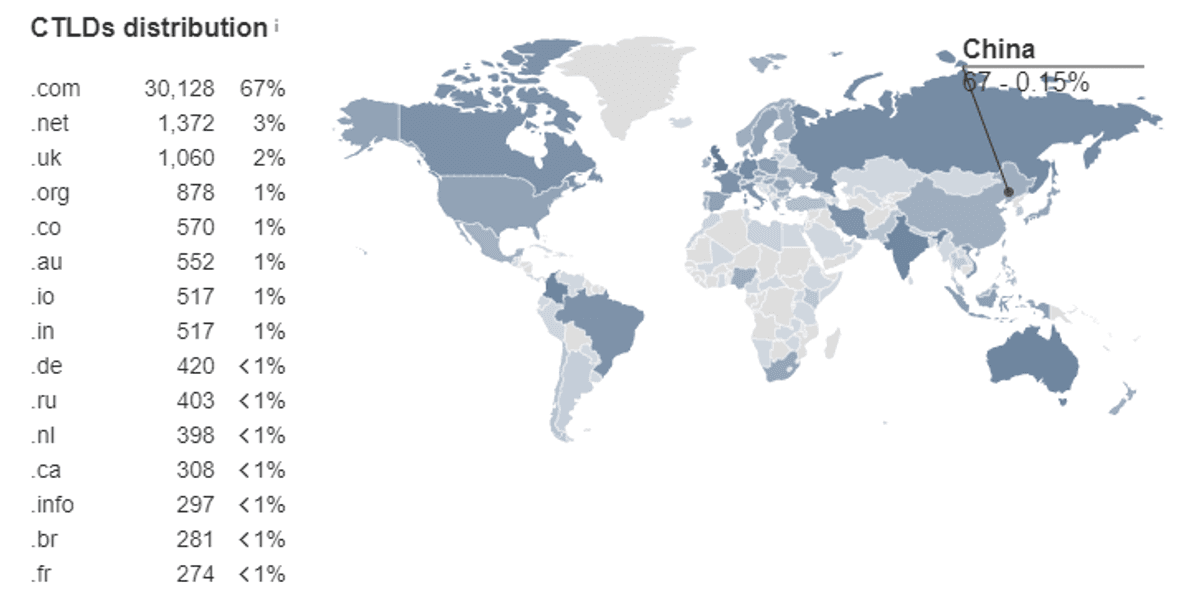
Step five: Review Anchor Text
Anchor text is words on your site that contain hyperlinks. They are the clickable parts of the text that redirect visitors to other pages.
People will often use branded anchor text or anchor text related to your articles.
You can see examples of this in the image below—it shows the anchor text for the running magazine, Runner’s World.
The most-used text relates directly to the brand or to running-related topics.

You may have a problem if a lot of your links have anchor text that is unrelated to your website content.
👉 We have put together a guide that discusses optimal anchor text optimization.
Be especially aware of anchor text relating to topics like casinos, loans, or pharmaceuticals.
What to do If you find bad backlinks
If you find harmful links, you have two basic options.
➡️ The first is to simply leave it as is. All websites attract spammy links, and Google is typically quite good at ignoring them.
If your website has a relatively small percentage of bad links and you’re generating traffic from Google, you probably don’t need to do anything further.
➡️ But if you have a lot of bad links and are worried that they may cause a manual penalty from Google, you can disavow the links.
5) Look for Content Refresh Opportunities
A backlink audit can highlight opportunities to increase your traffic by refreshing stale content.
The idea is to identify pages on your website with many links but not much search traffic.
You can then refresh the page and optimize it for a specific keyword to give it a better chance of ranking.
First, you must head back to the top pages by links report in Ahrefs.
You can then click on the drop-down menu of each page to see an estimate of how much organic referral traffic it receives.
If you notice a page has many links but not much traffic, it could be time for a content refresh.
The key to improving your rankings is to identify why the page doesn’t have search traffic despite its links.
There are several reasons why this may be the case:
👉 The page is old and needs an update.
👉 The page isn’t well-optimized for SEO.
👉 The page doesn’t meet what search engines consider to be the searcher intent for the keyword.
What Is Searcher Intent?
Also known as user intent, searcher intent is what Google thinks a user is looking for when they search for a particular keyword.
You have the highest chance of ranking when your page meets what Google considers to be the right intent.
It’s easy to discover searcher intent by looking at the articles that already rank for a keyword.
Take the query “Best SEO tool.” All articles that rank for this term are lists of tools.
If your article targeting the keyword is about why your product is the best SEO tool, you stand little chance of ranking. In this situation, you should update your content so that it is a list.
Before updating a page, check the pages that rank for the target keyword.
If they have more backlinks and authority than your page, you may still find it hard to rank even after an update.
6) Identify 404 Errors
404 errors occur when a link points to a page on your website that no longer exists.
This is bad for the user experience because when someone clicks on the link, they get an error instead of the content they want.
It’s also bad for link building because the link juice from referring domains is lost when it goes to a 404 error.
➡️ The good news is that there’s an easy solution. All you have to do is redirect the old URL to a new page on your website. This can also be referred to as fixing dead backlinks.
➡️ Once you do this, anyone who visits the old page will be sent to the new one. And the juice will also be directed to the new page.
Ahrefs makes it easy to find 404 errors and go about fixing dead backlinks. All you have to do is click on the “Broken backlinks” report in the “Backlink profile” sidebar menu.
This will highlight all the broken backlinks on your own site as well as the pages that point to them.
Below you can see three broken backlinks on Backlinko.com:

When we click on one of these links (from Neilpatel.com) we can see it takes us to a broken error page.

Once you’ve found broken links, you need to set up a 301 redirect to a new page on your website.
This is relatively easy to do using either:
👉 An SEO plugin like Yoast.
👉 By editing your site’s .htaccess file.
👉 By using a tool provided by your website host.
7) Check out Your Competitors
Once you’ve completed all the above steps, you should have a decent overview of your website’s backlink profile.
Another step is to perform the same checks on your competitors’ websites.
This will help you compare your site’s backlink profile to the profiles of sites you compete with.
You can use this information to see where you can improve and gain data for your next link building strategy.
👉 We have further information about how to check your competitor backlinks in a guide.
8) Check for a negative SEO attack
Negative SEO attacks—also known as black hat SEO—is when someone uses malicious methods to tarnish your website and ruin the trust you’ve built with Google.
Usually, the intent behind a negative SEO attack is to steal search rankings for competing keywords.
Some attackers will even assume your identity and contact websites that have linked to your web pages and ask for these links to be removed—which is the last thing you want.
Conducting regular audits of your backlink profile will help you identify negative SEO attacks before they affect your rankings and undo all your hard work.
Wrapping up on Backlink Audits
Not only is a backlink audit an excellent way to find areas that you can improve on, but it’s also your best option when it comes to picking up potential issues.
Once you’ve completed your audit, you’ll know what you can fix to bolster your search engine rankings—like dead backlinks—and you’ll know what to include in your backlink-building strategy.
If you want a clear path forward for your link building efforts, an audit is the best place to start.
We’re experts in carrying out thorough and comprehensive backlink audits for our clients as we know just how beneficial it can be. If you’d like to learn more about backlink audits and how we can help, get in touch with us via our website.

